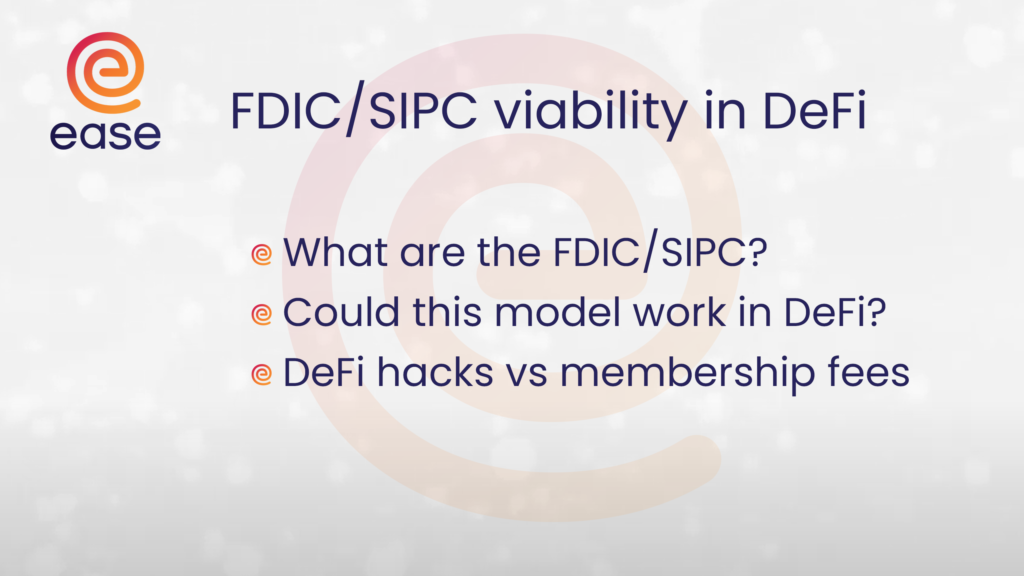Introduction
In the U.S., government-supported organizations protect most users of traditional finance by providing a sort of insurance on their deposits.
Among other things, these organizations protect funds in registered Institutions from being lost through insolvency or due to bank failures.
Would a similar organization work in DeFi?
What are the FDIC & SIPC?
The FDIC
The FDIC protects deposits in banks up to certain limits. If a bank becomes insolvent, the FDIC will preserve or liquidate its assets and begin to pay back customers.
The FDIC spends much of its budget on its Supervision and Consumer Protection program. The program is concerned with the examination of banks to assess their operating conditions, management practices and policies, and compliance with applicable laws and regulations. It also makes sure participating American commercial and savings banks comply with consumer protection laws. About $1.1 billion was spent on that program, thus making up 58% of its spending in 2021.
It spent $227m on bank failure resolution and receivership management of these resolved funds. Further, It spent $316m to manage its Deposit Insurance Fund, and lastly, $303m was for so-called “Corporate General and Administrative expenditures”. That makes a total of $1.9b in FDIC operating expenditures. A more detailed view of their expenditures in 2021 can be found on their annual report here: https://www.fdic.gov/about/financial-reports/reports/index.html
The SIPC
The SIPC protects user holdings in broker-dealers. If a broker-dealer loses your securities through insolvency, the SIPC will step in to liquidate their assets and bring legal action against anyone necessary to return as many funds as possible.
Both of these organizations function well to protect consumers against loss in traditional finance, but they’re tailored for that purpose.
Apart from being able to raise funds through charging an assessment rate, which acts like a membership fee or insurance cost for institutions, the majority of their functionality comes from the ability to liquidate assets and take legal action against responsible parties. This may not be likely or even possible with DeFi.
Could this model work in DeFi?
DeFi hacks–at the moment–are not only more prevalent and more costly (in terms of percent of the industry). They are also less likely to result in a return of stolen funds.
The most effective method to make up for lost funds from users in DeFi is not litigation. It’s repaying users with funds from the organization. While the SIPC does this at times, it is often not needed since most of the funds are recovered.
The SIPC’s Board of Directors decided that the 2022s assessment rate will be .0015% of the gross revenue of the member investment firms. Similarly, small numbers apply to the FDIC, where established institutions with more than 5 years of insurance under their belt pay between 0.015% to 0.4% of revenue.
DeFi hacks vs membership fees
Hackers got hold of about 0.25% of DeFi TVL (not revenue) in relatively safe protocols last year. Because we cannot rely on recovering any of these funds, we must assume that the membership fee would need to be big enough to payout these losses directly.
Furthermore, limiting these losses to a maximum dollar amount cannot be trusted to lower payout requirements because it’s trivial to split investments between addresses.
This means that Maker with a TVL of $7.9B (according to defillama.com), for example, would need to pay about $20M per year for their membership fee. That is if we assume that 0.25% will stay a constant risk percentage for relatively safe protocols, excluding operational costs. Uniswap, which makes no revenue from trades, would need to pay about $15M per year, according to the same estimation.
While these are very rough estimates, it’s clear that these membership fees are not sustainable for many DeFi protocols.
Conclusion
The exact format that the FDIC and SIPC employ within the #TradFi system may not work in DeFi and third-party insurance protocols will always be needed. However, we do believe there’s a spot in the ecosystem for a DeFi-native organization with similar goals. More on that coming soon…
This article is part of a new series of Thought Pieces, in which team and community members explore the past, present and future of DeFi.
Ease.org’s mission is to help make DeFi easy and safe for everyone to use. We’re asking the big questions, and want to engage our readers in the dialogue. Let’s cover every dollar in DeFi with native blockchain solutions! Join us! Join the conversation!



